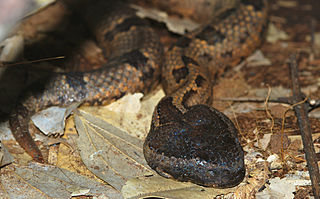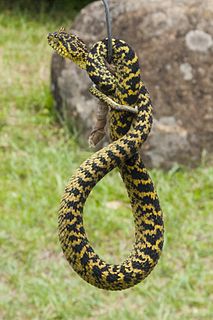
Children's python is a species of nonvenomous snake in the family Pythonidae. The species is named after John George Children. It is a nocturnal species occurring in the northern half of Australia and generally found on the ground, although it often climbs trees. Usually growing to about 1.0 m (3 ft) in length, it is typically a reddish-brown colour, darker on the upper surface, and with many darker blotches, especially on younger specimens. It feeds mostly on small mammals and birds, and as with other pythons, it constricts its prey before swallowing it whole. It is a popular pet among reptile enthusiasts.

Ovophis monticola is a venomous pitviper species found in Asia. Currently, two subspecies are recognized, including the nominate subspecies described here. Recent taxonomic work suggests that most of these should be considered as separate species. IUCN has already evaluated O. m. makazayazaya as Ovophis makazayazaya.

Protobothrops jerdonii is a venomous pit viper species found in India, Nepal, Myanmar, China, and Vietnam. Three subspecies are currently recognized, including the nominate subspecies described here.

Protobothrops mucrosquamatus is a venomous pit viper species endemic to Asia. Common names include: brown spotted pit viper, and pointed-scaled pit viper. No subspecies are currently recognized. The species was first described by Theodore Cantor in 1839.

Trimeresurus erythrurus, commonly known as the red-tailed bamboo pitviper, redtail bamboo pit viper, and redtail pit viper is a venomous pit viper species found in South Asia and Myanmar. No subspecies are currently recognized.

Trimeresurus gramineus, known as the bamboo pit viper, Indian green pit viper, or common green pit viper, is a venomous pit viper species found in the southern and north eastern parts of India. It is the type species for the genus Trimeresurus.
Uropeltis ocellata is a non-venomous shield tail snake species found in southern India.
Uropeltis rubrolineata is a nonvenomous shield tail snake species endemic to southern India. No subspecies are currently recognized.

Atheris ceratophora is a venomous viper species endemic to a few mountain ranges in Tanzania. This used to be the only horned, arboreal viper known from Africa, until the discovery in 2011 of Atheris matildae, also found in Tanzania. No subspecies are currently recognized.

Bothrops ammodytoides is a venomous pit viper species endemic to Argentina. No subspecies are currently recognized.
Letheobia simonii is a blind snake species endemic to the Middle East. No subspecies are currently recognized.

Agkistrodon contortrix mokasen is a venomous pit viper subspecies found in the eastern United States.
Bothrops pulcher is a venomous pitviper species found in South America. The specific name is Latin, meaning "beautiful", in reference to the color pattern. No subspecies are currently recognized.
Leptotyphlops nigricans, also known as the black threadsnake or black worm snake, is a species of snake in the family Leptotyphlopidae. It is endemic to Africa.

Rhinotyphlops schinzi, commonly known as Schinz's beaked blind snake, is a species of snake in the family Typhlopidae. The species is endemic to southern Africa.
Letheobia somalica, also known as the highland beaked snake or Ethiopian blind snake, is a species of snake in the family Typhlopidae. It is endemic to Ethiopia.
Rhinotyphlops unitaeniatus, commonly known as the yellow-striped blind snake or the Kenya beaked snake, is a species of snake in the Typhlopidae family. It is endemic to Africa.
Bibron's blind snake is a species of snake in the family Typhlopidae. The species is endemic to southern Africa.
The Bahamian slender blind snake is a species of snake in the family Typhlopidae.

Afrotyphlops schlegelii, commonly known as Schlegel's beaked blind snake or Schlegel's giant blind snake, is a species of snake in the family Typhlopidae. The species is endemic to eastern and southern Africa, and bears the distinction of being the world's largest typhlopid. It is harmless to humans and lives exclusively on a diet of termites.










